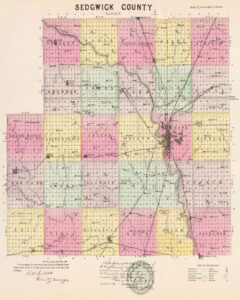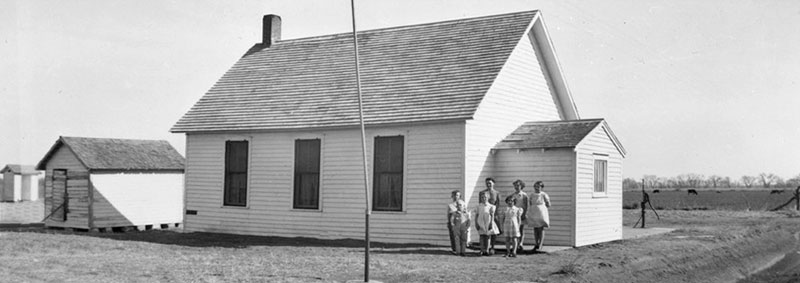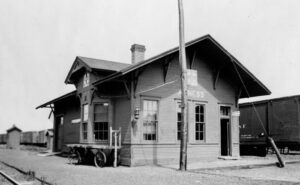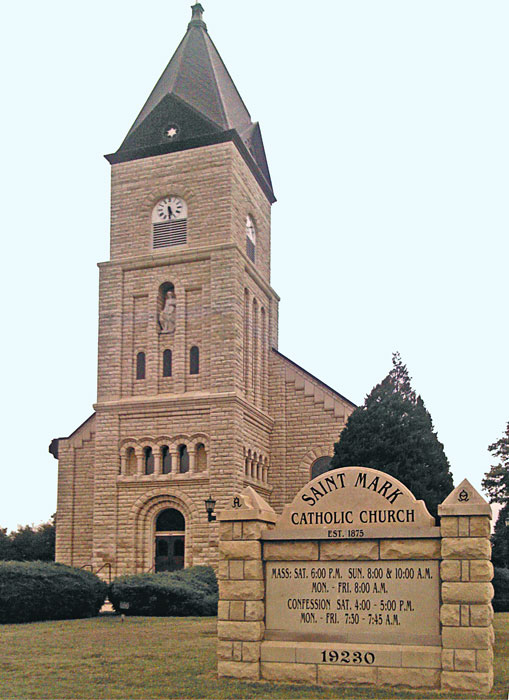| Town | Post Office Dates | Additional Information |
| Afton | 1874-1886 | |
| Aleppo | 1891-1903 | A small hamlet located about 15 miles west of Wichita and five miles northwest of Goddard, which had the most convenient railroad station. |
| Anness | 1887-1952 |
Anness was founded in the 1880s by W.H. Wilson when the Atchison, Topeka & Santa Fe Railroad began to be built. It was named for his wife. In 1910, it had a grain elevator, an express office, a few stores, and a population of 70. It was located in Erie Township, about 30 miles southwest of Wichita, near the Sumner County line. |
| Bayneville | 1884-1934 | A station on the Missouri Pacific Railroad in Ohio township, 12 miles southwest of Wichita. In 1910, it had a money order post office with one rural route, express and telegraph offices, some retail trade, and was a shipping point of some importance. |
| Birch | 1879-1894 | A station on the Missouri Pacific Railroad. |
| Blendon | 1875-1884 | It was located in Attica Township, ten miles west of Wichita. In the early 1880s, it had two stores, a restaurant, and a blacksmith shop. When the post office closed, it moved to Goddard. |
| Clonmel | 1905-1938 | A village of Illinois Township, it was a station on the Kansas City, Mexico & Orient Railroad 15 miles southwest of Wichita. In 1910, it had a post office, a general store, and a population of 40. |
| Clarion | 1871-1885 | Clarion was in the center of Lincoln Township. |
| Coronado | 1877-1882 | |
| Delano | 1871-1876 1879-1880 |
Once another rowdy Kansas cowtown, it is now a historic neighborhood of Wichita in Sedgwick County. |
| Diana | 1878-1881 | |
| Dry Creek | 1871-1872 | |
| Eldridge | 1872-1886 | |
| Fayette | 1875-1884 | |
| Ferris | 1877-1882 | |
| Furley | 1887-1953 | A station on the Chicago and Rock Island Railroad 15 miles northeast of Wichita. In 1910, it had a money order post office with one rural route, telegraph and express offices, general stores, and implement houses. It was the principal shipping point for a rich agricultural district in the northeastern part of the county. The population in 1910 was 52. |
| Germania | 1877-1896 | A small town about one and a half miles west of St. Mark, in Garden Plain Township. Its population was mainly composed of Germans. In the early 1880s, it had several stores, a post office, a hotel, a good school, and a church building. |
| Gladys | 1888-1891 | |
| Good River | 1876-1882 | |
| Hatfield | 1884-1886 | The post office moved to Maize. |
| Helen | 1877-1882 | |
| Herald/Finlay | 1877-1882 | The name changed from Finlay to Herald on March 19, 1879. |
| Hukle | 1887-1903 | The post office moved from Boon. |
| Iowaville | 1874-1902 | |
| Jamesburgh | 1873-1880 | Located a little over two miles northwest of Wichita. It was laid out in the winter of 1872-73 and named for James Morgan, the proprietor. It once had a store, shop, and post office, but they were gone by the early 1880s. |
| Kalamazoo | 1883-1887 | The post office moved to Anness. |
| Lamont | 1877-1884 | |
| Louise | 1877-1880 | |
| Magnolia | 1877-1889 | The post office moved to Andale. |
| Marshall | 1876-1883 | It was located in Grand River Township, on the Ninnescah River. In the early 1880s, it was described as a busy village with a flouring mill, two stores, two blacksmith shops, two feed stables, a broom factory, a boarding house, a hotel, and a restaurant. Marshal died when the Atchison, Topeka & Santa Fe Railroad bypassed it to the South. When the post office closed, it moved to Cheney. |
| Minneha/Manchester | 1871-1900 | Located in Minneha Township, it was a station on the St. Louis and San Francisco Railroad. |
| North Wichita | 1888-1901 | Located on the Atchison, Topeka & Santa Fe Railroad five miles north of Wichita. |
| Oatville | 1884-1936 | Located in Waco Township, it was on the Missouri Pacific Railroad, six miles southwest of Wichita. In 1910, it had telegraph and express offices, a money order post office with one rural route, and a population of 44. |
| Ohio Centre | 1873-1887 | |
| Park City/Cosmosa | 1870-1876 | Cosmosa was platted in 1870 by C. A. Nichols, J. A. McIlvain, F. C. Hawkins, and D. A. Bright. It was at first a formidable rival of Wichita, but it risked all on the county seat and lost. The name changed from Cosmosa to Park City on April 21, 1871. When Park City was bypassed by the railroad, the town died, and most of the buildings were moved to Wichita, Newton, and Hutchinson. |
| Payne | 1884 | The post office was only open for a month. |
| Ruby | 1879-1894 | |
| Saint Mark | 1879-1903 |
It was located on the line between Union and Attica Townships amid a German settlement. In the early 1880s, it had a large Catholic Church, school buildings, a post office, a general merchandise store, drug store, hotel, blacksmith shop, and tin and carpenter shops. The population in 1910 was 60. The church still stands today. |
| Schulte | 1906-1934 | Located in Waco township on the Kansas City, Mexico & Orient Railroad, 12 miles southwest of Wichita. In 1910, it had a general store, livery barn, telegraph and express offices, and a population of 70. |
| Sedowa | 1886-1903 | |
| Sunnydale/Sunny Dale | 1877-1901 | The name changed from Sunny Dale to Sunnydale on September 14, 1894. It was located 12 miles north of Wichita. The population in 1910 was 50. |
| Venice | 1880-1892 | |
| Waco/Cowskin | 1870-1905 | Indian village. The name changed from Cowskin to Waco on February 25, 1873. |
| Wichita Heights | 1888-1900 |

Sedgwick County, Kansas by L.H. Everts & Co, 1887.
©Kathy Alexander/Legends of Kansas, updated March 2024.
Also See:
Sources:
Blackmar, Frank W.; Kansas: A Cyclopedia of State History, Vol I; Standard Publishing Company, Chicago, IL 1912.
Cutler, William G; History of Kansas; A. T. Andreas, Chicago, IL, 1883.
Kansas Post Office History



